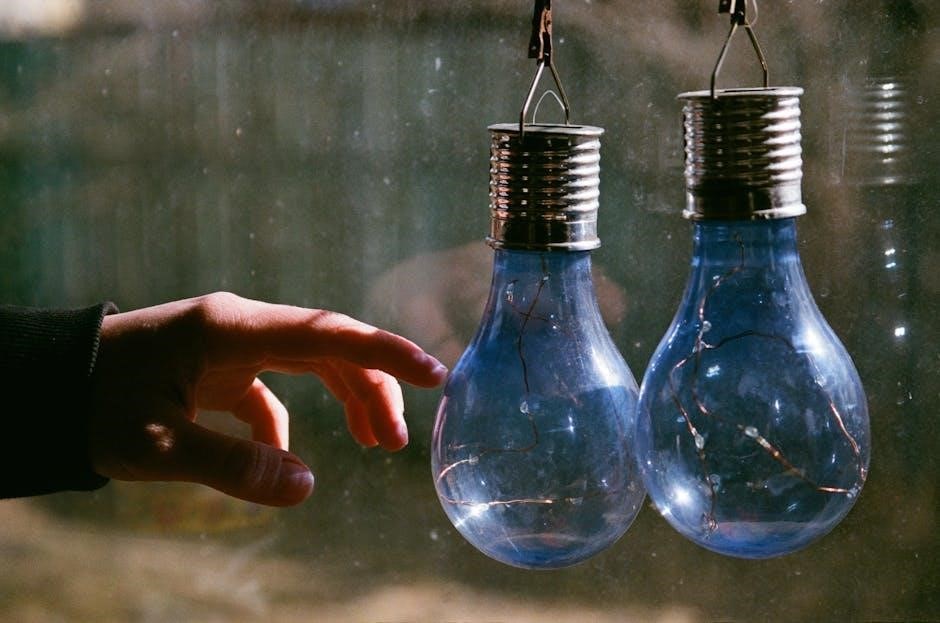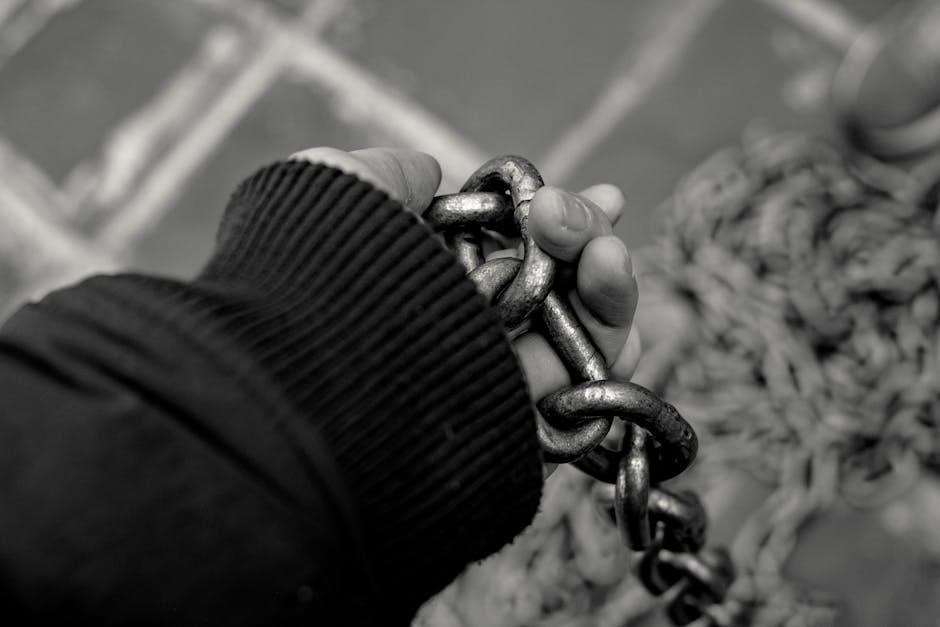drz400 chain cam guide touching chain
The DRZ400 cam chain guide touching chain issue arises from excessive tension, misalignment, or wear, causing noise and potential damage. This guide explores causes, symptoms, and solutions to address the problem effectively.
1.1. Overview of the DRZ400 Cam Chain Guide Design
The DRZ400 cam chain guide is a critical component designed to stabilize the cam chain, ensuring proper engine operation. Typically constructed from durable materials like nylon or aluminum, it is mounted under the swingarm to maintain chain alignment. The guide’s design aims to prevent excessive chain movement, which can lead to wear and noise. However, due to factors like excessive tension or misalignment, the chain may rub against the guide, causing issues. This overview focuses on the guide’s structure and its role in maintaining cam chain stability, highlighting how its design contributes to the touching chain problem when compromised.
1.2. Importance of Proper Cam Chain Tension and Alignment
Proper cam chain tension and alignment are crucial for the DRZ400’s engine performance. Incorrect tension can lead to excessive wear on the chain and guide, while misalignment causes the chain to rub against components, generating noise. Both issues can result in premature wear and potential engine damage. Maintaining the correct tension ensures smooth operation, reduces wear, and prevents the chain from touching the guide unnecessarily. Regular checks and adjustments are essential to uphold optimal functionality and longevity of the cam chain system.
1.3. Why the Cam Chain Touches the Guide
The cam chain touches the guide primarily due to excessive tension or misalignment. Over-tightening causes the chain to press against the guide, leading to wear. Misalignment, often from improper installation or guide wear, forces the chain out of its intended path. Additionally, a worn or damaged chain can sag, making contact with the guide. These issues are common in high-mileage DRZ400s and can result in noise and premature wear. Addressing the root cause, whether through adjustment, replacement, or realignment, is essential to prevent further damage and maintain engine efficiency.
Symptoms of Cam Chain Guide Wear on DRZ400
Noise from the cam chain area, visible wear on the chain or guide, and performance issues like misalignment are common symptoms of cam chain guide wear on DRZ400.
2.1. Noise from the Cam Chain Area
One of the earliest signs of cam chain guide wear is unusual noise from the cam chain area. This noise can range from faint rattling to loud clattering sounds, especially during acceleration or deceleration. The chain may slap against the guide or surrounding components, creating metal-on-metal contact. Over time, this noise can become more pronounced as the guide and chain wear down further. Riders often notice this issue during routine rides, making it a critical indicator of potential mechanical problems that require immediate attention to prevent further damage.
2.2. Visible Wear on the Cam Chain or Guide
Visible wear on the cam chain or guide is a clear indicator of an issue. Metal shavings, frayed chain links, or noticeable grooves on the guide are common signs. The chain may appear unevenly worn, and the guide might show excessive scratching or deformation. Inspection often reveals that the chain has been rubbing against the guide or nearby components, causing premature deterioration. This wear can lead to further complications if not addressed promptly, emphasizing the need for regular maintenance and inspection to prevent costly repairs. Visible damage is a direct sign that action is required to ensure the engine’s longevity.
2.3. Performance Issues Related to Cam Chain Misalignment
Cam chain misalignment can lead to noticeable performance issues, including reduced power output and decreased engine efficiency. Riders may experience inconsistent throttle response or engine hesitation, particularly under acceleration. Misalignment can also cause the chain to slap against nearby components, leading to increased wear and potential mechanical failure. Over time, this can result in costly repairs if left unaddressed. Regular inspections and adjustments are crucial to maintain optimal performance and prevent further damage to the engine and associated components. Prompt action ensures the DRZ400 operates smoothly and efficiently.

Causes of Cam Chain Guide Touching the Chain
The DRZ400 cam chain guide touching chain issue is primarily caused by excessive tension, misalignment, worn components, or lack of regular maintenance, leading to premature wear and noise.
3.1. Excessive Cam Chain Tension
Excessive cam chain tension is a primary cause of the chain touching the guide. Over-tightening strains the chain, causing it to press against the guide, leading to rapid wear. This friction generates noise and can result in guide failure. Riders often tighten the chain beyond recommended specifications, unaware of the damage it inflicts. Proper tensioning is critical to prevent premature wear and ensure smooth engine operation. Always refer to the manufacturer’s guidelines for correct tension adjustment to avoid this common issue.
3.2. Worn or Damaged Cam Chain
A worn or damaged cam chain significantly contributes to the guide touching issue. Over time, chain stretch or wear reduces its effectiveness, causing misalignment. Damaged links or rollers can catch on the guide, leading to abnormal contact. This wear not only affects performance but also increases the risk of chain failure. Regular inspections and timely replacements are essential to prevent such issues. A worn chain should be replaced promptly to maintain proper tension and alignment, ensuring the longevity of both the chain and guide.
3.3. Misaligned Cam Chain Guide
Misalignment of the cam chain guide is a common cause of the chain touching issue. If the guide is not properly aligned with the chain, it can lead to uneven wear and abnormal contact. This misalignment often results from improper installation or wear over time. Symptoms include increased noise and visible wear on the guide or chain. Addressing misalignment requires precise adjustment or replacement of the guide to ensure proper chain tracking. Regular checks and correct installation practices are crucial to prevent this issue and maintain optimal engine performance.
3.4. Lack of Regular Maintenance
Lack of regular maintenance is a significant contributor to the cam chain guide touching chain issue. Over time, dirt, wear, and improper lubrication can cause the chain and guide to deteriorate. Without periodic inspections, misalignment or tension issues may go unnoticed, leading to premature wear. Failing to clean and lubricate the chain can also exacerbate friction, increasing the likelihood of contact with the guide. Regular maintenance, including chain cleaning, lubrication, and tension checks, is essential to prevent such issues and ensure smooth engine operation.
Inspection and Diagnosis of the Cam Chain Guide
Inspect the cam chain guide for visible wear, misalignment, or damage. Check chain tension and listen for unusual noises. Ensure the chain runs smoothly without touching the guide.
4.1. Visual Inspection of the Cam Chain and Guide
A visual inspection is crucial to identify wear on the DRZ400 cam chain and guide. Look for signs like metal shavings, scoring, or uneven wear on the guide’s surface. Check the chain for stretching or excessive wear. Ensure the chain isn’t touching the guide improperly, as this can cause premature damage. Use a flashlight to inspect hard-to-see areas. If the guide shows significant wear or the chain is damaged, replacement may be necessary to prevent further issues. Regular visual checks can help catch problems early, ensuring optimal performance and longevity of the engine components.
4.2. Checking Cam Chain Tension
Checking cam chain tension is vital to ensure proper operation and prevent issues like the chain touching the guide. With the bike on a side stand, locate the cam chain tensioner. Use a socket wrench to loosen the tensioner bolt, then manually tighten it until resistance is felt. Tighten an additional quarter to half turn. Over-tightening can cause the chain to rub against the guide, while under-tightening may lead to slack. Proper tension ensures smooth engine operation and prevents premature wear. Always refer to the manual for specific torque specifications and periodic inspection intervals to maintain optimal performance and avoid costly repairs.
4.3. Listening for Unusual Noises
Unusual noises from the cam chain area, such as rattling, clunking, or metallic sounds, often indicate issues like improper tension or misalignment. These noises may be more pronounced during acceleration or deceleration. If the chain is touching the guide excessively, it can produce a distinct rubbing or slapping sound. Ignoring these noises can lead to further damage, so it’s crucial to address them promptly. Regularly listening for such sounds during rides or maintenance checks helps in early detection of potential problems, ensuring the cam chain and guide remain in good working condition and preventing costly repairs down the line.
4.4. Tools Needed for Inspection
For inspecting the cam chain guide, essential tools include a socket set, torque wrench, and pliers. A chain tension gauge ensures proper adjustment, while a ruler or caliper measures wear. A flashlight aids visibility, and a service manual provides guidance. Optional tools like a chain tension gauge and specialized wrenches can enhance precision. Having these tools ready facilitates a thorough inspection, helping identify issues promptly and ensuring accurate adjustments for optimal performance and longevity of the cam chain and guide system.

Replacement of the Cam Chain Guide
The replacement of the cam chain guide involves removing the old component, inspecting the area, and installing a new guide. Proper fitment ensures smooth chain operation.
5.1. Steps to Remove the Old Cam Chain Guide
To remove the old cam chain guide, start by accessing the area under the swingarm. Use a socket set to remove the bolts securing the guide. Gently pry the guide away from its mount, taking care not to damage surrounding components. If the guide is stuck due to wear or debris, apply gentle force or use a soft mallet. Once removed, inspect the area for any remaining debris or damage. Ensure all bolts are set aside safely for reinstallation with the new guide. Use a torque wrench to ensure proper torque specs when reinstalling later.
5.2. Installing a New Cam Chain Guide
Begin by cleaning the mounting area thoroughly to ensure a proper fit. Align the new cam chain guide with the mounting points, ensuring it is seated correctly. Secure it using the provided bolts, tightening them in a star pattern to avoid misalignment. Use a torque wrench to apply the recommended torque specified in the service manual. Double-check the guide’s alignment with the cam chain to prevent future issues. Once installed, inspect the area to ensure no debris or tools remain. Proper installation is crucial for maintaining chain tension and preventing wear. Always refer to the manual for specific torque values and alignment instructions.
5.3. Adjusting the Cam Chain Tension After Replacement
After installing the new cam chain guide, adjust the cam chain tension to prevent excessive slack or tightness. Use a torque wrench to tighten the tensioner according to the manufacturer’s specifications. Ensure the chain moves smoothly without binding. Start the engine and let it idle briefly to settle the chain. Recheck the tension and adjust as needed. Proper tension ensures quiet operation and prevents premature wear. Always refer to the service manual for specific torque values and adjustment procedures. Periodic checks are recommended to maintain optimal chain performance and avoid future issues.

Replacement of the Cam Chain
Replacing the cam chain ensures proper engine function and prevents damage from wear or misalignment. Follow precise steps to install a new chain, ensuring correct tension and alignment for reliable performance and longevity.
6.1. When to Replace the Cam Chain
Replace the cam chain when it shows visible wear, such as elongation, rust, or excessive slack. If the chain has been rubbing against the guide due to misalignment or improper tension, replacement is essential to prevent further damage to engine components. Additionally, if the chain has been in use for a high number of miles or if there are signs of fatigue, such as a “stretched” appearance, it is crucial to install a new chain. Regular inspections can help determine if replacement is necessary before major issues arise.
6.2. Steps to Remove the Old Cam Chain
To remove the old cam chain, start by accessing the chain area, which may require removing the swingarm or other components. Release the tension using the cam chain tensioner, ensuring it is fully relaxed. Carefully lift the chain off the sprockets, taking note of its routing to avoid misalignment during reinstallation. If the chain is stuck or rusted, gently pry it loose. Once removed, inspect the area for debris and clean as needed. Always refer to a repair manual for specific steps tailored to the DRZ400 model to ensure proper removal and preparation for the new chain installation.
6.3. Installing a New Cam Chain
Installing a new cam chain begins with ensuring the area is clean and free of debris. Carefully route the chain around the sprockets, aligning it properly to avoid misalignment. Use a chain tensioner tool to set the correct tension, ensuring the chain is not too tight or too loose. Apply a small amount of chain lube to reduce friction and prevent wear. Double-check the chain’s alignment and tension before starting the engine. Proper installation ensures smooth operation and prevents future issues like guide wear or noise.
6.4. Ensuring Proper Cam Chain Alignment
Proper cam chain alignment is critical to prevent wear and noise. Start by visually inspecting the chain’s path, ensuring it is straight and evenly seated on the sprockets. Use a chain alignment tool to verify proper positioning. Gently rotate the engine to check for any binding or misalignment. Ensure the chain moves smoothly without rubbing against the guide or other components. Correct alignment prevents premature wear and ensures optimal engine performance. Regular checks and adjustments are essential to maintain proper alignment and avoid potential issues down the road.

Tools and Materials Needed
Essential tools include a socket set, torque wrench, and chain tension gauge. Materials needed are a new cam chain guide, cam chain, guide bolts, and lubricant.
7.1. Essential Tools for Cam Chain Guide Replacement
To replace the cam chain guide on your DRZ400, you’ll need a socket set, torque wrench, and chain tension gauge. A cam chain guide tool is also recommended for proper alignment. Additional tools include a breaker bar for stubborn bolts, punches for marking the chain, and screwdrivers for minor adjustments. Ensure all tools are compatible with your specific model to avoid complications during the process. These tools will help ensure a smooth and accurate replacement, minimizing the risk of further damage or misalignment.
7.2; Recommended Tools for Cam Chain Replacement
For replacing the cam chain on your DRZ400, essential tools include a chain breaker, cam chain alignment tool, and impact wrench. A tension gauge ensures proper chain tension, while a chain wear indicator helps assess chain condition. Additionally, screwdrivers, punches, and a marker are useful for marking and aligning the chain. These tools ensure accurate replacement and prevent misalignment, making the process safer and more efficient. Proper tools are vital for maintaining the integrity of the cam chain system and ensuring optimal engine performance.
7.3. Materials Needed for the Job
Essential materials for replacing the cam chain guide include a new cam chain guide, chain lube, and a replacement cam chain if needed. Gaskets, locknuts, and a chain wear indicator are also recommended. Cleaning supplies like solvent and rags are necessary to prepare the area. Optional materials include a chain tension gauge and silicone-based spray for rust prevention. These materials ensure a smooth replacement process and help maintain the longevity of the cam chain system. Proper materials are crucial for preventing further wear and ensuring optimal engine performance.
Maintenance Tips to Prevent Cam Chain Guide Issues
Regularly inspect the cam chain and guide for wear and lubricate the chain. Adjust chain tension periodically and replace worn components promptly to prevent issues.
8.1. Regular Inspection of the Cam Chain and Guide
Regular inspection of the cam chain and guide is crucial for early detection of wear or misalignment. Check for signs of fatigue, excessive play, or contact marks on the guide. Use a clean, well-lit workspace and ensure the chain is clean before inspection. Pay attention to any unusual noise or vibration while riding, as these can indicate issues. Inspection should be part of routine maintenance, ideally every 1,000 to 3,000 miles, depending on usage and conditions. Addressing problems early prevents costly repairs and ensures optimal performance.
8.2. Proper Lubrication of the Cam Chain
Proper lubrication of the cam chain is essential to prevent wear and ensure smooth operation. Use a high-quality motorcycle chain lube, applying it evenly to the chain’s rollers and pins. Avoid over-lubrication, as it can attract dirt and debris. Lubricate the chain every 500 miles or after washing the bike. For the DRZ400, silicone-based chain sprays are recommended. After lubrication, wipe off any excess with a clean cloth to prevent residue buildup. Regular lubrication prevents rust, reduces friction, and extends the life of the cam chain and guide, ensuring optimal performance and minimizing the risk of chain and guide contact issues.
8.3. Adjusting Cam Chain Tension Periodically
Regular adjustment of the cam chain tension is crucial to prevent excessive wear and ensure proper engine operation. Over time, the cam chain can stretch, leading to slack, while overtightening can cause the chain to touch the guide. Check the tension every 500 miles or as specified in the service manual. Use a torque wrench to ensure accurate adjustments. Proper tension prevents noise, misalignment, and premature wear of both the chain and guide. Neglecting this maintenance can result in costly repairs. Keep the chain taut but not overly tight to ensure smooth engine performance and longevity of the cam chain system.
Upgrades and Aftermarket Solutions
Upgrading to high-performance cam chain guides and chains can enhance durability and reduce wear. Adjustable tensioners and premium materials improve performance and prevent the chain from touching the guide.
9.1. High-Performance Cam Chain Guides
High-performance cam chain guides are designed to reduce wear and prevent chain contact. Made from durable materials like aluminum or reinforced polymers, they offer improved heat resistance and longevity. These guides often feature precise CNC machining for a perfect fit and smooth operation. Aftermarket options include adjustable guides that allow fine-tuning of chain alignment, minimizing the risk of misalignment-induced wear. Some high-end models also incorporate noise-reducing features, ensuring quieter engine operation. Upgrading to a high-performance guide can significantly extend the life of your cam chain and improve overall engine performance. They are a popular choice among DRZ400 enthusiasts seeking reliability and enhanced durability.
9.2. Upgraded Cam Chain Options
Upgraded cam chains for the DRZ400 are designed to offer enhanced durability and performance. Many aftermarket chains feature advanced materials, such as O-ring or X-ring designs, which improve lubrication retention and reduce wear. These chains are often constructed with higher-strength steel for increased longevity. Brands like DID, RK, and JT offer high-quality options tailored to the DRZ400’s specifications. Upgrading the cam chain can help prevent issues like stretching or misalignment, which contribute to the cam chain guide touching the chain. Ensure compatibility with your bike’s model year and engine specifications before installation for optimal performance and reliability.
9.3. Adjustable Cam Chain Tensioners
Adjustable cam chain tensioners offer precise control over chain tension, reducing the risk of the chain touching the guide. These tensioners are designed to maintain optimal tension, preventing excessive wear and noise. Made from durable materials like billet aluminum, they provide long-lasting performance. By allowing fine adjustments, they help maintain proper chain alignment and reduce the likelihood of guide contact. Many aftermarket options are available, catering to the DRZ400’s specific needs. Installing an adjustable tensioner can enhance reliability and simplify maintenance, ensuring smoother engine operation and extending component lifespan.

Case Studies and Real-World Examples
DRZ400 owners report issues like excessive chain tension and worn guides causing chain contact. Successful repairs often involve replacing guides and chains, with lessons learned emphasizing regular maintenance.
10.1. Common Scenarios Leading to Cam Chain Guide Wear
Excessive cam chain tension is a primary cause of guide wear on the DRZ400. Riders often overlook proper tension adjustments, leading to premature wear. Misalignment due to improper installation or lack of maintenance also contributes. Additionally, aggressive riding and high mileage exacerbate the issue. Owners have reported that neglecting regular inspections allows minor issues to escalate, resulting in costly repairs. These scenarios highlight the importance of adhering to maintenance schedules and understanding the mechanics of the cam chain system to prevent wear and tear.
10.2. Successful Repairs and Upgrades
Many DRZ400 owners have successfully addressed cam chain guide wear by replacing worn components and adjusting chain tension. Upgrading to high-performance cam chain guides and chains has proven effective in reducing wear. Some riders have installed adjustable tensioners to maintain optimal chain alignment. Regular maintenance, such as cleaning and lubricating the chain, has also prevented further issues. These repairs and upgrades not only restore performance but also extend the lifespan of the cam chain system. Proper diagnosis and timely intervention are key to avoiding costly damage and ensuring reliable operation of the DRZ400.
10.3. Lessons Learned from DRZ400 Owners
DRZ400 owners have shared valuable insights from their experiences with cam chain guide issues. Many emphasize the importance of proactive maintenance, such as regular inspections and chain tension adjustments. Riders who addressed the problem early avoided costly repairs. Upgrading to aftermarket guides and chains has been a common solution for long-term reliability. Others highlight the need for proper tools and techniques during repairs to prevent further damage. These lessons underscore the value of community knowledge and real-world experience in maintaining the DRZ400’s performance and longevity.
The DRZ400 cam chain guide touching chain issue is preventable with proper maintenance and timely inspections. Regular checks, correct tension adjustments, and high-quality replacements ensure optimal performance and longevity.
11.1. Summary of Key Points
The DRZ400 cam chain guide touching chain issue primarily arises from excessive tension, wear, or misalignment. Regular inspections, proper lubrication, and timely replacements are crucial for maintaining optimal performance. Addressing these issues early prevents damage and ensures smooth engine operation. Owners should monitor for symptoms like noise or visible wear, adjust tension periodically, and consider aftermarket solutions for enhanced durability. By following these guidelines, riders can extend the lifespan of their cam chain and guide, avoiding costly repairs and maintaining their bike’s reliability on and off the road.
11.2. Final Thoughts on Maintaining the DRZ400 Cam Chain Guide
Proactive maintenance is essential to prevent the DRZ400 cam chain guide from touching the chain. Regular inspections, proper tension adjustments, and timely replacements ensure optimal performance and longevity. lubrication and alignment checks are vital to avoid premature wear. Upgrading to high-quality components can further enhance durability. By adhering to these practices, riders can minimize mechanical issues, maintaining their bike’s reliability. Consistent care not only preserves the engine’s health but also ensures a smooth and enjoyable riding experience for years to come.